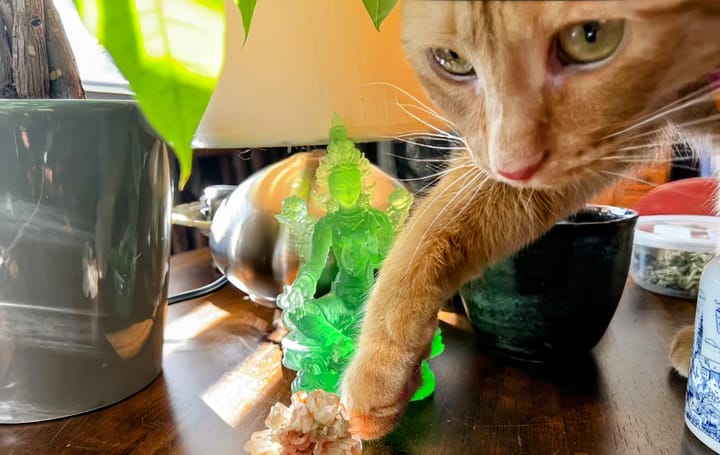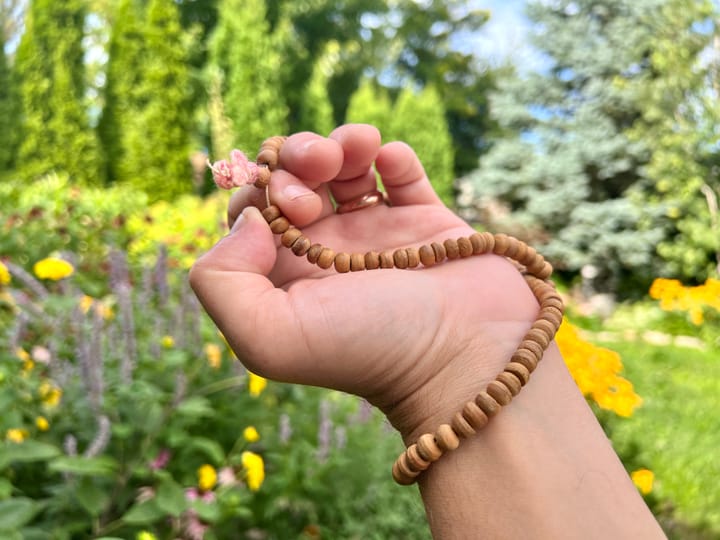Kindness in Space
My husband recently told me about a memory-care facility in the Netherlands that’s made to look like a tiny town, so it feels more familiar to the people who live there. That got me thinking about my mother-in-law, dementia, and the ways our physical environments can make us seem foolish or wise.

My husband Paddy just told me about a memory-care home in the Netherlands that is arranged like a little town. The corridors have the names of streets, and the seniors’ rooms are arranged to feel like apartments whose front doors open onto a public sidewalk, each of which has its own neighborhood character — rural charm, urban bustle, or quiet piety, for example. Every nexus of corridors is principally occupied by an important civic service — grocer’s, post office, restaurant, clinic — each of which is a perfectly realized miniature of the most common local version of its type. I imagine these miniatures have the sort of uncanny, meaning-saturated super-recognizability that AI pictures often have nowadays, and I am tempted to ask one of them to show me its bemused alien’s God’s-eye view of the idea of Dutch beauty parlor, just to see. (I resist the temptation because, never having been to the Netherlands, I enjoy picturing Delftware dairy-maids getting tiny blue tulips painted on their tiny white nails inside a wooden shoe.) The idea behind the facility, my husband explained, was to create the sort of space where people whose memories have been sanded down to the distant past would be able to recognize, instantly, the meaningful landmarks of home. “It seems very kind,” Paddy said, and I agreed.
The two of us contemplated The Dutch nursing home quietly in our garden, as bumblebees and butterflies attended to their business among the flowers. Paddy’s mother Millie, who is 94½ years old and by all accounts quite the character, lives in a very different sort of place. Thought I have not seen the Dutch home, I imagine it’s laid out very much like her memory-care facility in rural Minnesota: wide bright hallways, commodious nurses’ stations here and there, all the needful services in clearly marked areas of their own. When Millie calls my husband — the youngest of her six boys, her baby, and also a burly 58-year old man with a grizzled beard — from the nurses’ station where she lives, as she does relentlessly some days, she is having a senile delusions. She says, “I’m in the waiting room at the car dealership,” or “Come pick me up at the bank,” but of course she is in no such place.
In Millie’s sanded-down memory, at least from what I overhear, she lives in a farmhouse far outside Grand Forks, North Dakota. Her parents live there too, sometimes, along with some of her twelve brothers and sisters (all but two are dead), most or all of her sons (the oldest of whom is pushing eighty), and some of her sons’ senior spouses. As the most junior spouse, I myself was consigned to the sawdust of her memory early on. That makes me sadder than I thought it would. But I respect the structural justice of the process (last in, first out).
I suspect I must have been tricky for Millie to remember in the first place. Even a decade ago, when she was still quite sharp, there couldn’t have been a readymade conceptual nook in her mind to keep her baby’s same-sex spouse in. To this day, she has never once betrayed even the slightest discomfort about my relationship with her son — not just back when she was still able to be polite, but long after dementia had abraded away any lingering grooves of chilly Midwestern politeness. (To Millie’s credit, that layer of artifice had always been pretty thin.) Her acceptance of me always felt deep and genuine, quite as sincere as her opinions about my former academic career (“hah, you’re not so smart”), her husband’s tattoos (“it breaks my heart”), or my beard (“I’m going to cut it off while you’re asleep”). No matter how fond she was of me, though, a pious Ukrainian Catholic farm girl of her generation couldn’t have had a readymade category for an in-law of my particular description, any more than I can imagine a second cousin twice removed. The closest analogy I can imagine is the bachelor farmer who one day quietly moves in with another bachelor farmer, which I imagine sometimes occurred in rural North Dakota. But I don’t know if Millie ever knew of such an arrangement, and even if she did, the analogy is hardly precise.
At any rate, I can scarcely begrudge her weary brain the relief of no longer having to figure me out. When she’d forgotten my name and relationship to her son, but still recognized me as somebody familiar and friendly enough to holler at, it became clear that Millie’s son’s husband — a phrase even I, fifty years younger than she is, am still old enough to find uncanny — still fit, somehow, into the messy but roomy drawer that held Millie’s idea of kin. Until she forgot me altogether, she always told me she loved me, “like one of my own,” and I loved her right back. But now there is no longer any groove to hold the idea of “my son’s husband” on the ever-smoother surface of her memory.
Other ideas never really made much of a mark on her memory at all, like the ideas she would need to conceptualize the place where she now lives. Dedicated memory-care facilities were unknown in the world that formed her as a person, and even nursing homes themselves looked entirely different. Paddy tells me St. Anne’s, the only old-folks’ home Millie ever knew well, was a squalid disinfectant-smelling last resort run by dour nuns. (His sister maintains that the nuns were not dour, and made great efforts to engage the residents in social interaction, but she agrees that “the digs were yucky.”) Millie’s grandparents died at their farmhouse; so did her parents at their farmhouse, and so did most of her siblings at farmhouses, or regular houses, of their own.
Dying at home made sense to Millie and her kin because, in their experience, nursing homes were little better than prisons. I don’t just mean nursing homes from the distant past. Just six or seven years ago, the county exiled Millie’s best friend Ray (a noted boxer, musician, and bachelor bon vivant) to an old-folks’ home eight hours north-northwest of Grand Forks, almost at the Canadian border, after a neighbor found Ray on the floor of his farmhouse one winter, where he’d been lying for days. Millie still lived by herself at the time, though in retrospect she probably shouldn’t have. “Come bust me outta here, Millie,” Ray roared over the phone, “you gotta come bust me outta here!” — whereupon she hung up, put on her coat, tossed her little dog in the back seat of her bright-yellow truck, drove the eight hours north-northwest in the bitter cold, threw open the passenger door at the curb, and busted Ray outta there. “I never set one foot inside that place,” she crowed when she told Paddy about the caper. “Not one foot.”
Ray lived on the recliner in her TV room for several months after that, until a couple of Paddy’s brothers came and kicked him out for cause. He’d been pissing into the recliner since he couldn’t really walk, and tiny Millie couldn’t haul all six-feet-six of him up when he fell, which he did often. There was nothing to be done about it. Poor Ray did end up back in a nursing home, but by then Millie was already too far gone to visit him, much less bust him out.
At any rate, the first nurse’s station at a memory-care facility that Millie ever encountered in her near-century of life was the one she calls Paddy and his brothers and their senior wives from, sometimes thirty times a day, when the old head nurse quits (they’ve had four in four years) and the new head nurse doesn’t realize she has to re-approve Millie’s anti-anxiety meds every time, or Millie stops getting them and starts dialing. (The regulations that govern such matters seem designed largely to protect nonagenarians from ruining their lives by getting hooked on benzos.) The nurse’s station here looks like no place Millie has ever been before, so she does her best to guess. A clearly public place, seating meant for strangers, high ceiling, high counter, blond wood, gray and burgundy finishes, busy women typing behind glass: a hospital, a police station? Nothing in this environment legibly says what it is, or where, or what’s supposed to happen there, so Millie can only do her best to make inferences. “I’m just waiting here at the auto shop,” she says to her son on the phone, beside herself with worry, “please, please come pick me up.” It is very sad: she has dementia, she’s very far gone, and she doesn’t know where she is.
Later on I looked up an article on the Dutch memory-care place that Paddy mentioned, which describes it in sinister terms: as “a place where residents can live a seemingly normal life, but in reality are being watched all the time.” Of course being watched all the time is a normal life for many people right now — but the author is concerned about the seniors. “In some ways,” he frets to Yvette van Amerongen, the remarkable nursing home she founded
is similar to the manufactured reality depicted in the movie “The Truman Show,” where a man played by Jim Carrey discovers his entire life is actually a TV program. Everything he thinks is real is in fact a mirage. … van Amerongen dismisses any accusations that she and her staff are duping their residents. “We have a real society here,” she says. “I don’t think people feel fooled. They feel fooled if we just tell them a story that’s not true and they know it. We’re not telling stories.”
I think the founder of the place is being too modest: they’re doing the opposite of telling people “a story that’s not true.” The reality of van Amerongen’s place is certainly “manufactured,” but I think that’s equally true of any environment made by human hands. The set in the movie The Truman Show is manufactured no less than the set of the movie, no less than the soundstages and small towns where they film them, no less than the houses the crew and the actors go home to after they wrap for the day. A bank is a manufactured reality. So is a a circle of stones around a campfire. So is the nurses’ station at a memory-care facility. Because manufacture is a deliberate act, every human environment has its own opinions about what reality there can be like. The circle of stones around the campfire can be big enough to welcome or small enough to exclude. The bank that might once have resembled a tiny godless Greek temple now looks like a strange, sterile coffeeshop where nobody really drinks coffee. The memory-care facility can be manufactured to make foolish delusions of its residents’ bewildered attempts to describe their alien surroundings. Or, like van Amerongen’s place, it can be manufactured so the ways they describe their environment are true.
I imagine Millie at the Dutch place, calling up her youngest son. “Hi, Patrick,” she says.
“Hey mom! Whatcha doing,” he asks, as he always does.
“Oh, not much,” she replies. “I’m sitting outside the restaurant.”
We know exactly where she means: we’ve sat outside the restaurant too, on the park bench there, before we went in for lunch the last time we visited. The restaurant in question is a bright and sparse-tabled dining room where all the diners are quiet elders in wheelchairs, since after all we are in a memory-care unit. (I imagine everybody is wearing wooden shoes and eating from windmill-and-tulip china, though I know that is silly.) Outside the door is a sign with a restaurant’s name; just inside, there’s a host standing a little lectern, who shows you to your table. The employees who glide around the dining room perform the exact functions of waiters, providing food and drink upon request and clearing plates away. The food and drink are real, listed on a menu, and have been paid for; the dishes are done by others in a kitchen out of sight. For all intents and purposes, truly and literally, Millie is sitting outside a restaurant. This does not seem so very sad. Here too Millie has dementia, and she’s very far gone; but here she knows exactly where she is, which is exactly where we think she is too. Here she is not just another useless old lady experiencing a senile delusion in the memory-care facility Medicaid pays to warehouse her until her body dies. Here Millie is a patron, dining out.
The Dutch place, as I am imagining it, does something really quite marvelous. It certainly makes anxious and confused people feel safer, more capable, more at home. I imagine it also makes work infinitely more pleasant for the kind and gentle employees who take care of the old folks who live there. Working at a clinic in a memory-care unit is one thing; working at a clinic across the courtyard from the grocer’s, at the intersection of two streets with names, seems like quite another, and much less grim. But the real marvel, I think, is how its designers manufactured the reality of the place to accommodate both the memories of the residents and the contemporary experience of staff and families at the same time. This is what makes it so very kind.
The place where Millie lives is not kind at all. It’s not the place’s fault; its form follows its function, just as the people who work there live lives of shocking economic misery because that is what capital wants. Designing kind space, like paying personal-care assistants and nurses dignified wages, is not very efficient upfront, so capital has no patience for it. Imagine paying thoughtful people to wonder about what a particular set of old folks will remember, then to average all that out, and then to name the streets just right and spec the perfect cobblestone-patterned carpets for maximum familiarity. At Millie’s memory-care faculty — indeed, at most memory-care facilities in the Netherlands, too, from what I hear — capital has not allowed any humans to make such costly efforts. I hasten to say that Millie lives in a perfectly lovely facility, where all the staff really do try their best. But it is conceptually unkind.
To understand her day-to-day environment in anything like an accurate way, Millie would need a staggering array of concepts she and her contemporaries never had any need for, or needed so recently that dementia must have made quick work of them: asset forfeiture, prior authorization, Medicaid. When she calls Paddy and his brothers from the nurses’ station, over and over, demanding to be picked up from whatever public building she finds herself in, her best efforts to guess her own location diverge so dramatically from the reality her sons and the nurses inhabit that she seems to all of them like a foolish old lady. In that alien context, whose reality was manufactured without her brain in mind, that’s really all she can be.
In recent months, Millie’s dementia seems to be smoothing away the ideas of banks, car dealerships, and public buildings overall. Lately she mostly describes her surroundings as a small child might: my bed, my TV, a chair, a nurse. Increasingly, she and the staff of the place, and her sons, are living in the same reality, which includes only one room at a time. This change feels like a small blessing, in that Millie seems less and less delusional. But this thin sort of shared reality, so meagerly supplied with simple nouns, is not really a place where human sociability can flourish. These days, during their ever-briefer conversations, Paddy and his mother talk about her bed and her TV, which they agree about. His profession (visual merchandising), age (senior), and location (Minneapolis) are no longer remotely comprehensible, but it still pleases her very much to hear that he’s doing well for himself, and that he’s happily married. It really doesn’t seem to matter to whom; to Millie, married is good. When he visits her, he shows her pictures of the bees in our garden on his phone.
Now that I know about the kindness of the Dutch memory-care facility, I am starting to see other marvels of kindness all around me. The computer interface I’m typing in now is mostly an abstract series of overlaid boxes with images and text in each of them, but it is kind that in this reality the boxes are called “windows,” with “tabs,” on a “desktop.” These metaphors make no spatial sense all together, but they seem to work well enough that those of us who spend our days in their environment can describe them without seeming foolish or crazy. I can talk about to the tabbed windows on my desktop, even with someone who knows much more about computers than I do, and I will not seem delusional because the computer person calls them the same thing. The much-maligned skeuomorphic interfaces of software from years ago were kind in just that way. Carefully and deliberately, they bent an incomprehensible new environment into shapes most people could recognize, so nobody would have to sound like a crazy old lady, at least not for long.
Design theory calls little knobs and handles and such “affordances,” objects whose material reality helpfully suggests just how to interact with them. The kind door-handle shows you how to push on it before you even have to wonder. The horizontal bar on a door that opens inward, by contrast, makes you look like a crazy person while you push on it, which is not kind at all. Kind places are manufactured to fit comfortably into readymade grooves in the minds of the people who encounter them. The narrower and more homogeneous those people are, the more precise its kindness can be. For the team who designed the Dutch old folk’s home, it presumably took quite a bit of work — “human-centered design,” as it’s called — to realize the spatial ideals that their residents would find most familiar. No matter how well they performed that task, though, I imagine not all the seniors in the Dutch old-folks’ home find a little Dutch village reassuringly familiar. For some, whose oldest memories were formed in very different spatial worlds, a corner grocery store might be just as alien as a nurses’ station in a memory-care facility. But even if you grew up far from windmills and tulips, I suspect you’d still recognize paths as paths, doors as doors, and signs as signs. In fact, I think people can and do detect even the effort to be kind in this way, and feel welcomed because of it. Even a novel and mysterious affordance — a dial on an unknown machine, an unmarked button on a wall — is subtle but irresistible evidence that someone once made a deliberate effort to bend reality into a familiar shape to be kind to somebody else.
There is a German phrase, of course, for this tender abstract sense that an effort has been made: Zweckmäßigkeit ohne Zweck. I don’t know if the designers of the kind memory-care facility used the corresponding phrase in Dutch — “doelmatigheid zonder doel,” the internet tells me — to describe the effect they were shooting for, but I like to think they did. The phrase, coined by Immanuel Kant, describes the quality something has when you’re not sure what it’s for, but it seems indisputably for you — saturated with purpose and welcome, like a cake soaked in sweet milk. With something like the same attitude, the flowers in our garden seem to say to the bees, very kindly: you belong here, you are welcome, you are needed, we agree.
Thanks to Patrick Chudgar and Kris Vervaecke for their help.



